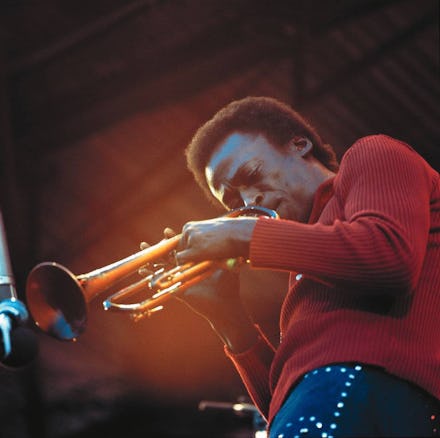Miles Davis Did More for Modern Music Than You Probably Ever Thought

At a White House dinner party in 1987, a politician's wife made the mistake of asking Miles Davis why jazz was essentially dead in America.
"Jazz is ignored here because the white man likes to win everything," Davis answered in his typically terse and brutal manner.
Shaken, she fired back: "Well, what have you done that's so important in your life? Why are you here?"
"Well, I've changed music five or six times," he told her, "What have you done of any importance other than be white — and that ain't important to me — so tell me what your claim to fame is?"
Six is a low-ball estimate as to how many times Davis changed music. This scene, which Davis relays in his autobiography, is one of the most vivid illustrations of Davis' fierce pride on record. But he could back it up. Davis was so intent on pushing the boundaries of his art that he changed the course of music in the process. He may have been a jazz musician, but he was fundamental to nearly all of modern music.
His first groundbreaking contribution to American music was the popularization of modal jazz in the 1950s. Davis likely became familiar with modal theory while attending Juilliard for a brief stint. He stayed a year before dropping out, choosing instead to learn jazz on the streets from the masters of the day — Charlie Parker, Thelonious Monk and Dizzy Gillespie — but he never forgot the expert theoretical knowledge that would have been inaccessible to most.
Most traditional Western music uses major and minor scales, but modal stretches far beyond that limitation. It de-emphasizes traditional chords, forcing the music to rely on melody, rhythm, timbre and emotion to create interest. These attributes are what make Kind of Blue, one of his first modal forays, the universally beloved masterpiece that it is. Many music critics consider it to be the perfect jazz album, and it became the standard to which all future jazz albums would be compared.
Not all of Davis' innovations were met with the same worldwide acclaim as Kind of Blue, but it's a testament to Davis that, slowly, they've become recognized as equally earth-shattering.
In the '60s, when Davis started getting fascinated with the more electronics-driven rock and funk music, many critics thought he was selling out. Yet all Davis was doing was finding new outlets for his boundless creative energy. The music Davis produced during this electric period wasn't just rock, though. It's now celebrated as laying the groundwork for future genres like hip-hop, trance, dub, new wave, drum and bass, grime, electro and dubstep.
Davis used James Brown, Sly and the Family Stone and Jimi Hendrix as his entry points into the genre. At 43 years old, he remade his sound and his style to fit these new influences. Davis started dressing like Hendrix, going as far as getting his hair done by Hendrix's hairdresser. Some likened it to a bit of a musical midlife crisis. But none of the music he released sounded derivative. It smashed the boundaries that had historically separated high-brow and low-brow art. Numerous musical innovators have cited this period in Miles' career as inspiration for their own musical reinventions. For one, Kanye West, who recently reinvented his beloved sound with his polemical Yeezus, frequently describes Davis as a kindred spirit.
In the early part of the electric period, Davis, along with famed producer Teo Macero, pioneered several tape-cutting techniques, which would become fundamental elements of early dance, break beat and hip-hop. For 1969's In A Silent Way, Davis and Macero "transformed some beautiful, folk-tinged, melody-driven sets into two exquisite, beguiling and otherworldly pieces of music ... outside any traditional or accepted jazz structure," as Nick Southall of Stylus wrote in a brilliant review of the album's construction. Many consider the endlessly mysterious piece to be the first jazz fusion album.
Davis pushed these tape and fusion techniques to their most ambitious and daring heights a year later on his seminal Bitches Brew. He arranged ensembles of 10 or more musicians to create a strong and fiercely tribal sound, only amplified by the album's celebratory Afro-centric artwork. The album's title track starts off as throttling ritual chant, while "Miles Runs the Voodoo Down" is a deeply sensual burlesque act. Numerous modern musical luminaries, such as Flying Lotus, Questlove and St. Vincent, have cited Bitches Brew as having a significant formative influence on their musical careers.
Davis could have easily ended his musical trajectory with the enigmatic "So What" and still gone down as a legend. But the man never stopped pushing.
"Miles was a searcher, an innovator," as Don Cheadle, director of an upcoming Davis biopic, described him to the New York Times. "If he was alive today, he'd be working with Kendrick Lamar or DJ Skrillex or Kanye."
The biopic, titled Miles Ahead, will highlight the progressive, innovative aspects of his character. Because Davis deserves to be remembered, even if jazz is dead. After all, that's only a small piece of his massive legacy.